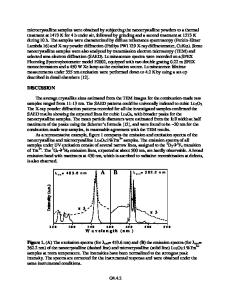Luminescence property and magnetic resonance imaging of Gd 2 O 3 :Tb 3+ nanocrystals doped with Zn 2+ , Li +
- PDF / 1,642,574 Bytes
- 10 Pages / 595.276 x 790.866 pts Page_size
- 60 Downloads / 313 Views
RARE METALS
ORIGINAL ARTICLE
Luminescence property and magnetic resonance imaging of Gd2O3:Tb3+ nanocrystals doped with Zn2+, Li+ Rong Fu, Yan-Yan Hu, Hui-Na Qiao, Chun-Lin Yang, Hao Yin, Mei-Gui Ou*
Received: 5 January 2020 / Revised: 28 February 2020 / Accepted: 9 September 2020 Ó GRINM Bohan (Beijing) Publishing Co., Ltd 2020
Abstract Gd2O3:Tb3? nanocrystal co-doped with Zn2? and Li? was prepared by the combination of polyol and solid-phase methods. The synthesized nanoparticles were characterized by X-ray diffraction (XRD), field emission scanning electron microscopy (FESEM), transmission electron microscopy (TEM), photoluminescence (PL) spectra and magnetic resonance imaging (MRI). The results revealed that both Gd2O3:Tb3?/Zn2? and Gd2O3:Tb3?/Li? had cubic unit structures with a spherical shape, and the fluorescence intensity of the nanoparticles reached a maximum at a doping concentration of 0.050 mmol% for Zn2? and 2 mol% for Li?, respectively. In addition, the T1/T2 (longitudinal/transverse relaxation time)-weighted MRI signals got enhanced due to the increased longitudinal relaxivity (r1) and transverse relaxivity (r2) after the doping by metal ions. Therefore, the materials reported here can be used for fluorescence and MR bimodal imaging, as tracers and for fluorescence detections.
R. Fu, Y.-Y. Hu, H.-N. Qiao, M.-G. Ou* College of Materials and Metallurgy, University of Guizhou, Guiyang 550025, China e-mail: [email protected] R. Fu, Y.-Y. Hu, H.-N. Qiao, M.-G. Ou National Local Co-construction Engineering Laboratory for High Performance Metal Structure Material and Manufacture Technology, Guiyang 550025, China C.-L. Yang College of Chemistry and Materials Engineering, Guiyang University, Guiyang 550003, China H. Yin Department of Neurosurgery, Guizhou Provincial People’s Hospital, Guiyang 550002, China
Keywords Gd2O3:Tb3?; Zn2?/Li? doping; Luminescent property; Magnetic resonance imaging; Nanomaterials
1 Introduction In recent years, the luminescent nanomaterials based on lanthanide rare earth oxides have attracted particular attention due to their special optical properties arising from the intra-4f electronic structure, which brings about excellent luminescence performance [1–5]. These structural characteristics make rare earth oxides widely usable in fluorescent imaging, bio-tracing, electronic display, solar cells, temperature sensors, etc. A large number of highly efficient luminescent rare earth compounds have been studied, including Y2O3:Eu3? [6], Eu2O3 [7], EuF3 [8], etc. Compared to traditional luminescent materials (metal sulfides, semiconductor quantum dots, organic dyes, etc.), the lanthanide oxides have the advantages such as narrow emission bandwidths [9], high photostability [10], long lifetimes [11], and lower cytotoxicity [12]. Among the lanthanide oxides, the cubic Gd2O3 is recognized as a suitable matrix material due to its chemical and thermal stability, low phonon energy, and ease of doping by other rare earth ions [13–16]. Therefore, the luminescence properties of phosphors ba
Data Loading...











